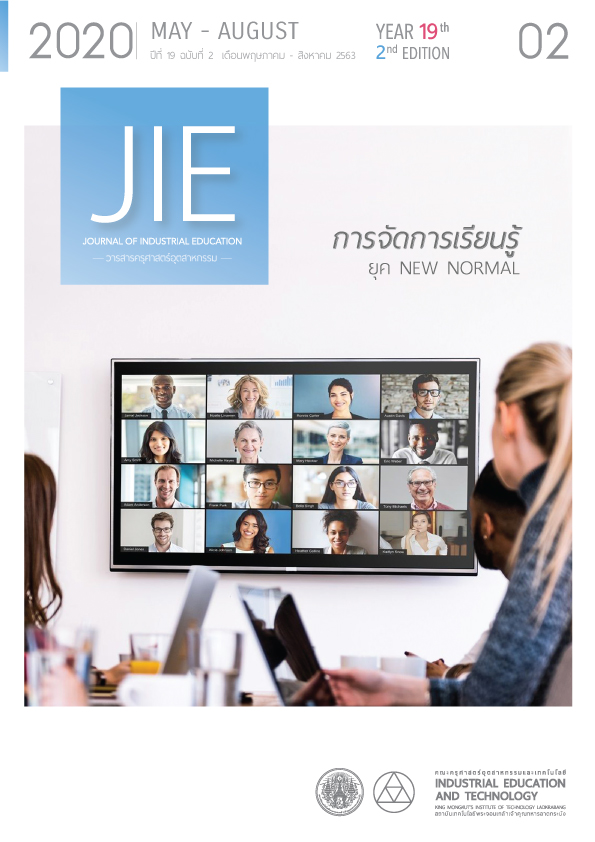A STUDY OF MATHAYOMSUKSA II STUDENTS’PROOF ABILITIES ON PARALLEL VIA CONJECTURING AND PROVING APPROACH WITH GEOGEBRA PROGRAM
Keywords:
Conjecturing and Proving, Proof Abilities, Mathematical AttitudesAbstract
The purposes of this study were as follows: 1) to study the proof abilities of Mathayomsuksa II students on parallel after being taught through the conjecturing and proving approach with GeoGebra program. 2) to compare their mathematical attitudes before and after being taught through the conjecturing and proving approach with GeoGebra program. The participants selected by a method of cluster random sampling were 40 Mathayomsuksa II students from Samutsakhonburana school in Samutsakhon province, during the second semester of the 2019 academic year. Percentages, mean ( ), standard deviation (S.D.), Z-test for population proportion and t-test for dependent sample were employed in analyzing data. The research instruments of this study were: 1) lesson plans that allowed students to learn the topic via conjecturing and proving approach with GeoGebra program, 2) the proof abilities test on the topic of parallel, and 3) the questionnaire for measuring mathematical attitudes. The study findings revealed that: 1) after being taught by the conjecturing and proving approach with GeoGebra program, over 60% of the participants had proof abilities on parallel score that satisfied the criteria at a significant level of .01, and 2) student’s mathematical attitudes were significantly higher than before the experiment at the level of .01
References
Archara Pacheenburawana. 2014. Mathematics for science. Bangkok: Thammasat University.
Mahachulalongkornrajavidyalaya University. 2016. Basic mathematics. 5th ed. Bangkok: Mahachulalongkornrajavidyalaya University.
Marasri Naewchampa. 2009. Normal Mathematics Teaching. Thai Science and Technology Journal, (96), p. 38-40.
Office of the Royal Society. 2011. Royal Institute Dictionary. Retrieved June 12, 2020, from http://www.royin.go.th/dictionary/
Panthong Gullanartsiri. 2013. Teaching Geometry at the elementary level in the 21st century. Journal of the Institute for the Promotion of Teaching Science and Technology, 26(102), p. 3.
The Institute for the Promotion of Teaching Science and Technology. 2013. Documents for Trainees, Distance Training Program for Teachers in Mathematics at Primary Level, Standard Curriculum for Teacher Training, Year 3 (Revised version). Bangkok: The Institute for the Promotion of Teaching Science and Technology. (Brochure).
Somsong Suwapanich. 2010. Geometry ... Amazing Science. Journal of Education, 7(1), p. 33.
Trairong Klumbut. 2014. The Development of Activity Packages to Enhance Reasoning Ability on Reasoning about Triangle and Quadrangle for Mathayomsuksa 3 Students. Master of Education (Science Education), Naresuan University.
Thamarut Kreethathorn. 2015. The Effects of Mathematics Proving Activities in the Topic of Parallel Lines on Mathematics Learning Achievement and Mathematics Resoning of Mathayom Suka II at Chumchonwadsainoi School in Nonthaburi Province. Master of Education, Sukhothai Thammathirat Open University.
Sathapana Bonmark. 2015. The Effects of Concept Attainment Model on Mathematical Concept and Reasoning Ability in Parallel Lines of Mathayomsuksa II Students. Phetchabun Rajabhat Journal, 17(1), p. 21-32.
Natchailai Prinkmadee. 2001. A Study of Mathematics Concepts Parallel Lines of Lower Secondary School Students. Master of Education (Mathematics Education), Chulalongkorn University.
Morselli, F. 2006. Use of examples in conjecturing and proving: An exploratory study. International Group for the Psychology of Mathematics Education, 4, p. 185.
Aricha-Metzer, I. and Zaslavsky, O. 2017. The nature of students’ productive and non-productive example-use for proving. The Journal of Mathematical Behavior, 53, p. 304.
Nguyen, D. N. 2012. The Development of the Proving Process Within a Dynamic Geometry Environment. European Researcher, 32(10-2), p. 1731-1744.
Lin, F.L., et al. 2011. Principles of Task Design for Conjecturing and Proving. Proof and Proving in Mathematics Education, p. 305-325. Dordrecht: Springer.
Chanya Uthit. 2014. Effects of Organizing Learning Activities on “Linear Programming” Supplementing Mathematical Skills and Processes by Using The GeoGebra for Mathayomsuksa Six Students at Samutsakhonburuna School, Changwat Samut Sakhon. Master of Education (Teaching Mathematics), Kasetsart University.
Pongsak Wuttisan. 2013. GeoGebra is another interesting option for math teachers. IPST Magazine, 41 (181), p. 13-16.
Munnanicha Kamkaew. 2017. A Study of Learning Achievement on Relations Between Two-Dimensional Geometric Figures and Three-Dimensional Geometric Figures of Mattayomsuksa 1 Students Using Cooperative Learning STAD Technique and GeoGebra Program. Master of Education (Mathematics Education), Nakhon Ratchasima Rajabhat University.
Veeris Kittivarakul. 2018. A Study of Mathayomsuksa III Students’ Conceptual Knowledge and Proof Abilities on Circle Via Conjecturing and Proving Method with GeoGebra Program. Master of Education (Mathematics Education), Srinakharinwirot University.
Yupin Pipitkul. and Preecha Naoyenphon. 1994. "The proven teaching model" in the subject matter syllabus Nitty-gritty and mathematical methods, units 8-11. Nonthaburi: Sukhothai Thammathirat Open University.
Downloads
Published
How to Cite
Issue
Section
License
"The opinions and contents including the words in papers are responsibility by the authors."
"ข้อคิดเห็น เนื้อหา รวมทั้งการใช้ภาษาในบทความถือเป็นความรับผิดชอบของผู้เขียน"



